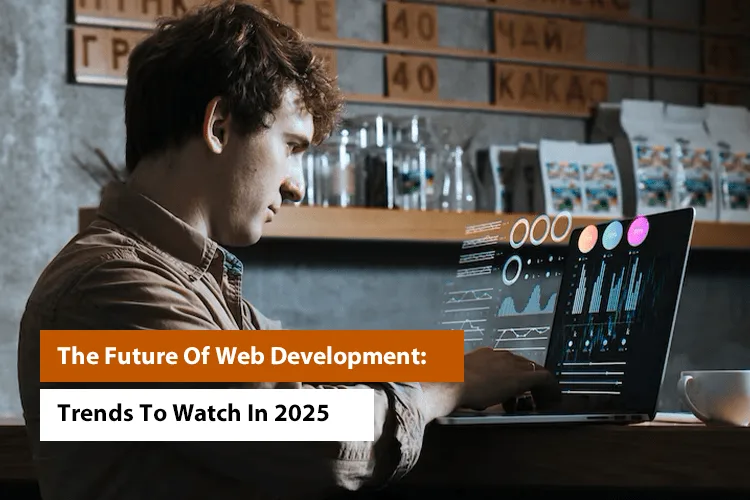The Future Of Web Development: Trends To Watch In 2025

The internet is not simply a place to discover information; it has become a world of creativity, enterprise, and connections. Every year, we see massive changes in how web development. We also see big changes in how apps are created and used.
For businesses, these trends are more than just changes. They are chances to grow, connect with users, and stay ahead in a tough market. For web development experts, learning about these changes is very important. It’s the way to create new ideas and AI shapes the future of online experiences.
In this blog, we’ll figure out the most exciting web development trends composed to redefine the industry in 2025.
The Rise of AI-Powered Web Development

Artificial Intelligence (AI) is converting how web applications are made, customized, and controlled. In 2025, AI will nonetheless be very vital in net development. It will help developers work faster and smarter. Businesses can use AI to create websites that feel more personal for users. Here’s a closer look at the impact of AI in web development:
AI-Driven Personalization in Web Applications
Personalized experiences are no longer a comfort; they are a necessity. AI allows web applications to adapt actively to user behaviors and preferences:
Websites can analyze user data in real-time to suggest relevant products, articles, or services.
Behavioral analysis tools use AI to customize layouts. They also customize messaging and content based on user interactions.
In e-commerce, AI makes dynamic pricing possible. Personalized promotions are another benefit. These features lead to higher engagement and conversion rates.
Use Cases
AI’s actual global programs in web improvement are developing swiftly:
Chatbots now provide constant customer care and are getting wise. With AI such as GPT-4, they can keep better conversations and understand context more clearly.
Platforms like Netflix and Amazon use AI. They suggest movies or products tailored to individual preferences.
Websites can anticipate user actions. For instance, they can predict the likelihood of a purchase or churn. Based on these predictions, websites can take proactive steps. To optimize outcomes accordingly.
Implications for Developers and Businesses
For Developers: Increased efficiency with AI-assisted coding and debugging. Opportunities to focus on creative problem-solving and higher-value tasks. Need for upskilling in AI technologies and machine learning frameworks.
For Businesses: Faster delivery of applications with reduced development costs. Enhanced user engagement through AI-driven personalization. Competitive edge in an AI-first digital landscape.
AI is no longer a futuristic concept in web development. It is now a core element of modern workflows.
Progressive Web Apps (PWAs): The Future of Steady Experience

Progressive Web Apps (PWAs) are a type of web application. They provide fast load times. Offline functionality is another feature of PWAs. Enhanced user engagement is also a benefit. They combine the best of web and mobile experiences, ensuring seamless performance across devices.
PWAs are reliable. They can work without internet connectivity. PWAs deliver an app-like experience directly through a browser.
Companies leveraging PWAs successfully in 2025
In 2025, leading companies are capitalizing on the power of PWAs to enhance user engagement and accessibility:
Starbucks: Seamless offline ordering experience.
Spotify: Faster streaming with reduced data usage.
Twitter: Instant access with lightweight performance.
These success stories demonstrate how PWAs redefine user experiences. They do this with speed, reliability, and cross-platform compatibility.
Essential Developer Tools and Frameworks for PWAs
Creating Progressive Web Apps is consistent with advanced tools and frameworks:
Google Lighthouse: Evaluate PWA performance and accessibility.
Workbox: Simplify service worker creation for caching.
Angular & React: Build scalable, PWA-ready applications.
This software streamlines development, ensuring rapid, engaging, and offline-successful web reports.
Web3 and Decentralized Applications (dApps)

Web3 is the coming massive step in the progress of the net. Unlike Web2, which is ruled by using centralized entities, Web3 prioritizes decentralization. Web3 provides users with greater control over their data and interactions. This isn’t like Web2, that is characterized by way of centralized entities in control.
Powered by means of blockchain generation, Web3 intends to create a virtual ecosystem. This surroundings is intended to be greater obvious, steady, and equitable. This decentralized model is reshaping internet development, and developing new opportunities for innovation.
Blockchain Technology’s Impact on Web Development
Blockchain, the foundation of Web3, is transforming how web applications are built and operated:
Enhanced Security: Immutable data storage and cryptographic protocols ensure robust security.
Transparency: Decentralized ledgers allow all participants to view and verify transactions.
Decentralized Hosting: Applications run on distributed networks. This reduces reliance on single points of failure.
Use Cases Driving Web3 Adoption
Web3 is bringing exciting applications to the forefront: Automated agreements that perform whilst predefined situations are met, removing intermediaries. Creation of digital tokens representing real-global assets like art, actual estate, or collectibles. Social media, gaming, and finance systems are created on blockchain to present customers ownership and control.
Challenges and Possibilities in Web3 Development
While Web3 opens doors to innovation, it comes with hurdles:
Challenges: Scalability issues in blockchain networks. Steep learning curves for developers new to blockchain technology. Regulatory uncertainties in various regions.
Opportunities: Building applications with enhanced privacy and user empowerment. Early adoption in sectors like finance, healthcare, and supply chain management. The chance to create a fairer internet economy through token-based incentives.
Web3 and dApps represent a transformative shift in web development. Developers can address the challenges of creating decentralized digital solutions. By doing so, they can unlock unprecedented possibilities that are user-centric.
Serverless Architecture: A New Development Paradigm

Serverless architecture is a cloud computing version. Developers construct and run applications without coping with the underlying infrastructure in this model. The cloud provider handles server management, scaling, and resource allocation.
Benefits
Cost-effective: Pay only for actual usage.
Scalable: Automatically scales with demand.
Simplified management: No need to manage servers or infrastructure.
Platforms sans servers, such as AWS Lambda and Google Cloud Functions, permit developers to concentrate completely on code.
Serverless Architecture: Advantages, Supreme Platforms, and Case Examples
This type of architecture is a cloud computing version. Developers build and run applications without managing the underlying infrastructure in this model.
Cost Efficiency: With serverless, you best pay for what you operate, doing away with the need for idle server time. This reduces operational costs.
Scalability: Serverless platforms automatically scale based on demand. This means developers can manage traffic spikes without distressing about infrastructure.
Reduced Complexity: Developers can focus on writing code without managing servers or infrastructure. This speeds up the development process.
Leading Platforms
AWS Lambda
Azure Functions
Google Cloud Functions
Use Cases
Event-driven applications like file processing or notifications.
Real-time data processing and analytics.
Microservices architectures, where each service operates independently.
The future holds great potential. Serverless technology continues to evolve. It expands into more areas of application. This brings even greater possibilities.
The Evolution of User Interfaces: Voice, AR, and VR

UI design is changing quickly with voice controls, augmented reality (AR), and virtual reality (VR). These technologies are making websites and programs extra captivating and easier to use. Here’s how those traits are shaping the future of web improvement:
Voice-controlled Interfaces: Voice search and voice assistants are making web apps extra accessible. Examples of voice assistants, consisting of Alexa and Siri, are contributing to this fashion. They improve hands-loose navigation, especially for customers with disabilities.
AR-enhanced Web Experiences: AR brings websites to life by integrating real-world elements. For example, it offers interactive product visualizations and gamified interfaces.
VR-driven Platforms: VR is pushing boundaries in various industries. It offers fully immersive environments in gaming, education, and real estate.
Industries Adopting These Technologies
- Retail: Using AR for virtual try-ons and interactive shopping experiences.
- Healthcare: Leveraging VR for training and patient treatment simulations.
- Education: Implementing VR to create virtual classrooms and immersive learning environments.
Tools and Frameworks for Developers
Voice: Google’s Dialogflow and Amazon Lex.
AR: ARKit (iOS) and ARCore (Android).
VR: A-Frame and Unity3D.
Challenges
Creating seamless and responsive interactions.
Ensuring accessibility for all users.
Balancing immersion with usability to avoid overwhelming the user.
Cybersecurity in Web Development: A Growing Priority

As web apps grow and get more superior, the danger of cyber threats also will increase. Hackers are always coming up with new methods to assault websites, that may put vital information and business structures at hazard.
These attacks can encompass things like stealing private data or shutting down websites. Because of this, developers need to include sturdy protection functions when constructing internet packages to shield them from those risks.
Rising Cyber Threats and Their Impact on Web Applications
Increasing number of cyberattacks targeting web applications. Data breaches, identity theft, and ransomware as primary concerns. Exploiting vulnerabilities in outdated code and weak encryption. The financial and reputational damage caused by security failures.
Trends in Secure Coding Practices and Frameworks
Adoption of Secure Coding Standards: Use best practices like input validation. Encrypt data to protect it. Implement secure authentication. Prevent common vulnerabilities such as SQL injection. Defend against cross-site scripting (XSS) attacks.
Frameworks with Built-In Security: Platforms like Django and Ruby on Rails come with built-in security features. These platforms help mitigate common risks.
Focus on Continuous Security Testing: Conduct regular vulnerability assessments. Perform penetration testing to identify and fix security flaws early.
The Role of AI in Enhancing Web Security
AI-driven tools to detect unusual behavior and potential threats in real-time.
Automating threat detection and response through machine learning.
Predictive analytics to foresee future attack vectors and bolster defenses.
Best Practices for Developers in 2025
Prioritize User Privacy: Implement strong encryption for data at rest and in transit.
Use Multi-Factor Authentication (MFA): Add layers of security to user login systems.
Stay Updated on Emerging Threats: Follow cybersecurity trends. Update systems regularly to address new vulnerabilities.
Developers can prioritize these strategies. By doing so, they can better safeguard their web applications. Against the evolving landscape of cyber threats, their applications will be more secure.
Also Read:
Continuous Integration and Continuous Deployment: A Guide for Modern Enterprises
Embracing the Future of Web Development
As we move into 2025, web development is changing quickly because of new technology and the growing needs of users. The trends we’ve looked at—like AI tools for building websites, decentralized apps, new ways to interact with websites, and making websites more eco-friendly—are changing how we use the internet. These changes help improve how users experience websites and help businesses stay ahead in a world that is becoming more digital.
Looking Ahead
For developers and businesses, embracing these trends isn’t optional—it’s essential. By staying informed and adaptable, organizations can lead the charge in this transformative era. Developers should upskill in areas like AI, blockchain, and advanced UI/UX, while businesses must invest in sustainable and forward-thinking digital solutions.
At Imenso Software, we are committed to helping companies navigate these trends with confidence. Whether you need cutting-edge development expertise or strategic consultation, our team is here to bring your vision to life. Let’s build the future of web development together—today. Find us on Clutch to see how we have helped businesses like yours.
Want more information about our services?
Similar Posts

What Is CMS? And Why Your Website Must Have One
You can make a website in 10 minutes now, thanks to modern CMS platforms. And it’s not just a marketing campaign to entice business owners into trying a new tool. Building websites has never been easier. There are a vast number of no-code website builders available on the internet for free. You can create a […]...

NodeJS for Data-Intensive Applications: Use Cases and Best Practices
Are you struggling to ensure optimal performance and scalability for your data-intensive Node.js applications in the face of ever-growing data volumes and complex processing demands? Worry not, as we have the solution for you. By adopting effective monitoring and performance optimization practices, you can overcome these challenges and deliver high-performing, scalable, and reliable applications. In […]...

Scaling React.js Applications: Architectural Patterns and Performance Optimization
Are you struggling to keep your Reactjs applications running smoothly as it grows in size and complexity? Do you face performance bottlenecks and wonder how to handle an ever-expanding user base? Fear not, for we have the perfect solution to your scaling woes! Welcome to our comprehensive blog on Scaling React.js Applications: Architectural Patterns and […]...









